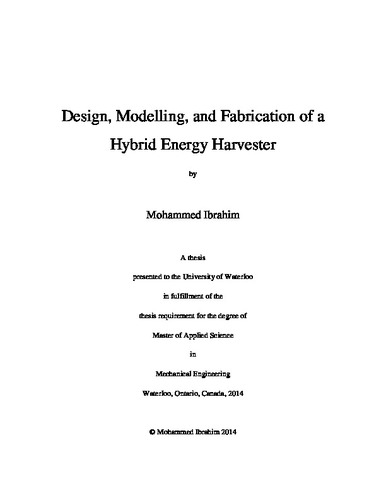| dc.contributor.author | Ibrahim, Mohammed | |
| dc.date.accessioned | 2014-01-23 15:15:41 (GMT) | |
| dc.date.available | 2014-05-24 05:00:25 (GMT) | |
| dc.date.issued | 2014-01-23 | |
| dc.date.submitted | 2014 | |
| dc.identifier.uri | http://hdl.handle.net/10012/8172 | |
| dc.description.abstract | As sources of energy are becoming more scarce and expensive, energy harvesting is receiving more global interest and is currently a growing field. Energy harvesting is the process of converting ambient energy, such as vibration, to electrical energy that can power a multitude of applications. Vibration energy is the by-product of everyday life; it is generated from any perceivable activity. While typically viewed as noise, there is a strong potential for harvesting this energy and deploying it to useful applications. The focus of this thesis will be using vibration as the ambient source of energy.
Hybrid energy harvesters employ more than one of the harvesting technologies. In this thesis, two hybrid harvesters that utilize piezoelectric, magnetostrictive, and electromagnetic technologies are designed, modelled, and tested. Both of these harvesters have beams that are spiral in shape. The use of the spiral geometry allows the system to have a lower natural frequency as opposed to the traditional cantilever beam, while still maintaining a high volume of active material.
The first harvester that is discussed is the P-MSM harvester. It utilizes piezoelectric and magnetostrictive material. Both materials are configured in a spiral beam geometry and allowed to resonate independently. The resonance frequency of these two materials is designed to create wideband energy harvesting. This allows the harvester to be operating efficiently even if the ambient vibration shifts a small amount.
The second harvester that is discussed is the P-MAG harvester. It utilizes piezoelectric and electromagnetic technologies. It also incorporates a spiral geometry for the piezoelectric layers and includes a magnet attached at the centre. The magnet is placed in the centre of the spiral to reduce the natural frequency of the system and to also actively contribute to the harvesting. This harvester has two sources operating at the same resonant frequency, which allows it to have a larger power output than if the sources were separated.
Finally, finite element analysis was used to model both harvesters. ANSYS was used for the piezoelectric material and COMSOL was used for the electromagnetic material. The results are compared to the experimental and are in good agreement. | en |
| dc.language.iso | en | en |
| dc.publisher | University of Waterloo | en |
| dc.subject | Energy Harvesting | en |
| dc.subject | Piezoelectric | en |
| dc.subject | Hybrid | en |
| dc.subject | Wideband | en |
| dc.subject | Magnetostrictive | en |
| dc.title | Design, Modelling and Fabrication of a Hybrid Energy Harvester | en |
| dc.type | Master Thesis | en |
| dc.pending | false | |
| dc.subject.program | Mechanical Engineering | en |
| dc.description.embargoterms | 4 months | en |
| uws-etd.degree.department | Mechanical and Mechatronics Engineering | en |
| uws-etd.degree | Master of Applied Science | en |
| uws.typeOfResource | Text | en |
| uws.peerReviewStatus | Unreviewed | en |
| uws.scholarLevel | Graduate | en |

